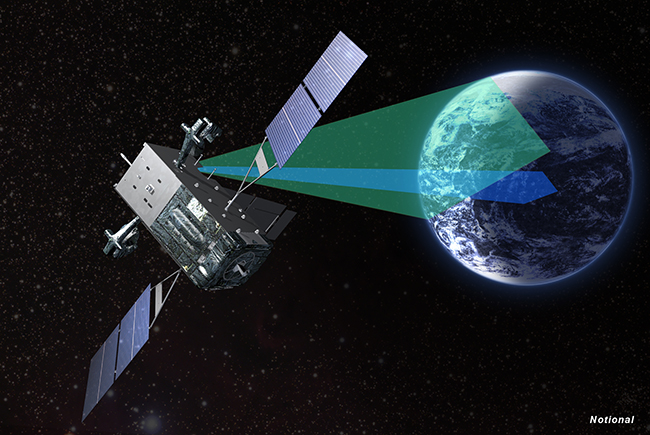
The Air Force is requesting $1.4 billion for the Next-Generation Overhead Persistent Infrared program, which will eventually replace the missile warning Space-Based Infrared System, shown here as an artist rendering. Lockheed Martin illustration.
The Air Force is significantly ramping up research and development funding for the Next-Generation Overhead Persistent Infrared program in its fiscal 2020 budget request after underfunding the program in 2019.
In September, the service anticipated next-gen OPIR would cost about $11 billion in R&D from 2018 to 2024, but updated cost estimates now anticipate the program will need $13.1 billion over the same time period.
In 2020, the Air Force is requesting $1.4 billion—more than double the money it requested the year before, according to the Air Force’s budget documents released earlier this month. The 2020 request is $52 million higher than the service said it needed that year in a slideshow presented last September, and it is $456 million more than projected for 2020 in last year’s budget submission.
“Space acquisition must respond with speed and agility to emerging adversary threats,” the service said. “Space and Missile Systems Center is transforming the organization … to an enterprise approach, maximizing innovation and resiliency, [and] leveraging international, commercial, and mission partnerships.”
OPIR efforts are broken into several parts: the Space Modernization Initiative, which studies and prototypes potential modifications to make the enterprise more affordable, capable, and effective; a ground program, which handles new ground stations for satellite command and control; and a space component.
“Justification for this increase includes a refined acquisition strategy that delivers an enterprise ground system to support operations of Next-Gen OPIR by 2025,” the budget says of the ground effort, also known as Future Operationally Resilient Ground Evolution. “FORGE … plans to present a formal acquisition strategy and request [rapid-acquisition] authorities” in late 2019.
Next-Gen OPIR Space is the next iteration of the legacy Space-Based Infrared System, and aims to field five missile-warning satellites in geosynchronous Earth orbit—which offers continuous coverage of very large regions—and two in an orbit that passes over the Earth’s poles. As part of Block 0, three GEO satellites and two polar satellites are expected to be on orbit by 2029. Three of those should be in space by 2028, according to the Air Force’s September presentation.
The missile-warning satellites in GEO and polar orbits “enhance detection and improve reporting” of intercontinental, submarine, and tactical ballistic missile launches, the budget says. Lockheed Martin and Northrop Grumman are building the new constellation, which also will use congressionally granted rapid-prototyping authorities.
Additional money in 2020 would pay to speed the time it takes to launch Block 0 GEO satellites and reduce schedule risk, to accelerate the launch timeline for the polar portion, and to speed ground system development. Block 1 acquisition is slated to start in 2023, so the first satellite would be delivered by 2030, the budget adds.
The program has been bolstered by reprogramming requests to offset underfunding. Next-gen OPIR is expected to ramp up to top $3 billion for annual spending in 2024, about $840 million more that year than was anticipated in the 2019 budget.
Last year, the Air Force said it wanted to cut OPIR satellite procurement time by four years.
“The next generation missile warning will be an important pace-setter for learning to speed up traditional acquisitions,” Air Force Acquisition Executive Will Roper said in May 2018. This is more than just building a prototype or a low-cost system. … This is an important system for the nation, and to ‘go for the gold’ by targeting five years instead of nine years allows us to pick up the pace.”
The September briefing noted that the service’s approach isn’t “five years or bust.” Five years would warrant a gold medal, but “seven years or less is a win.”